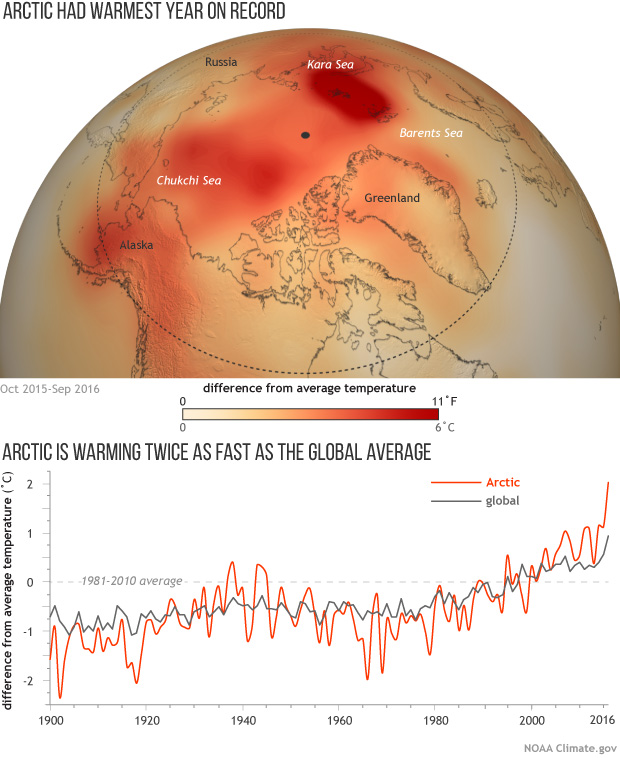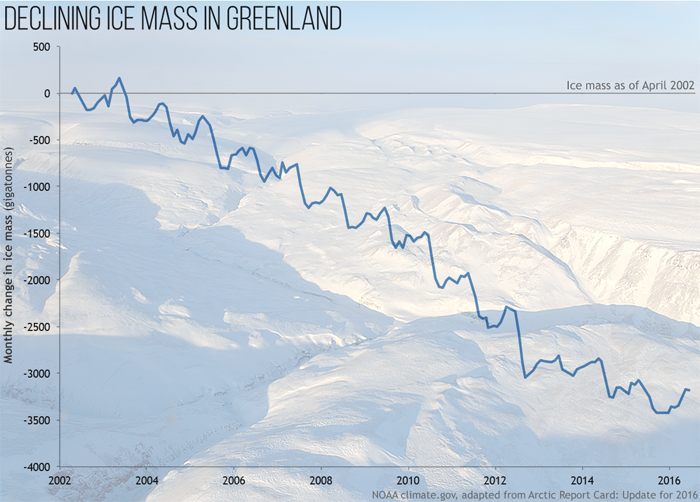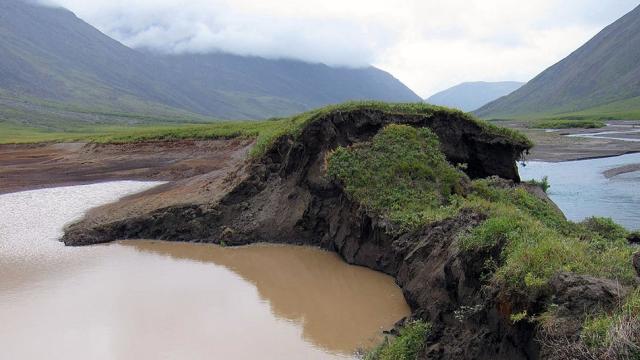The National Oceanic and Atmospheric Administration just released its annual “Arctic Report Card”, a comprehensive overview of what’s happening at our planet’s North Pole. If it were an actual report card, the Arctic would be on the verge of failing.
Photo showing permafrost thawing across an Arctic landscape. Image: NOAA
“In terms of sea ice, I’d say sea ice cover is a D+,” Dartmouth University geophysicist Donald Perovich told reporters at a press conference at the American Geophysical Union meeting today. “Because I’m an easy grader.”
As Perovich’s generous D+ indicates, Arctic sea ice has been having an astonishingly bad year, beginning with a record early spring thaw and continuing through an unprecedented autumn, during which ice cover has grown very slowly. In November, sea ice cover across the Arctic averaged just nine million square km, which is 1.95 million square km below the 1981 to 2010 average, according to the National Snow and Ice Data Center.
The culprit is obvious: Rising temperatures.
“A persistent warming trend over the Arctic is driving the changes we’re seeing,” Perovich said, noting that since the beginning of the 20th century, temperatures over the Arctic’s land surfaces have risen approximately 3.5C, which is roughly twice the globally-averaged rate of warming.
From September of 2015 to September 2016, Arctic temperatures were the highest on record, with new monthly record highs recorded for January, February, October and November. It’s important to note that records aren’t just being broken — they’re being shattered. Last month, the mercury was a whopping 20C above normal across vast swaths of the Arctic Ocean.

Map: temperatures across the Arctic compared with the 2015-2016 average. Graph: Yearly temperatures since 1900 compared with the 1981-2010 average for the Arctic (orange) and globe (grey). Image: NOAA
As temperatures continue to rise, Arctic sea ice cover will continue to fall, which is bad news for polar bears, whose numbers are now expected to decline 30 per cent over the next three to four decades. “Sea ice is the primary habitat for polar bears: they use it for travelling, hunting, finding mates, breeding,” explained Kristin Laidre of the University of Washington’s Polar Science Center, who presented the depressing polar bear outlook at an AGU press conference yesterday. “Looking forward, all subpopulations will be negatively impacted by a loss of ice.”
The effects of rapidly rising temperatures go far beyond hungry bears, however. As the latest Arctic report card highlights, sweeping ecological changes are now taking place across the land and sea.
Rising temperatures are stimulating the growth of phytoplankton, meaning parts of the Arctic ocean are becoming more biologically productive. At the same time, rising atmospheric CO2 levels are triggering ocean acidification, which causes tiny, shelled organisms to dissolve. This could have ripple effects up the food chain. As snow cover retreats, the tundra is getting greener and browner, with these darker surfaces absorbing more heat. Permafrost is thawing, and threatening to release vast quantities of buried soil carbon into the atmosphere.

Image: NOAA
Finally, Greenland is continuing to melt, shedding billions of tonnes of ice each year and causing global sea levels to rise. In 37 years of satellite observations, there was only one year in which Greenland began melting earlier than it did in 2016.
“We’ve seen a year in 2016 in the Arctic like we’ve never seen before,” said Jeremy Mathis of NOAA’s Arctic research program. “The report this year clearly shows a stronger and more persistent signal of pronounced warming than any other year in our record.”
“When [the report card] started, you had to listen closely because the Arctic was whispering change,” Perovich said. “Now it’s not whispering anymore. It’s speaking change and shouting change.”
